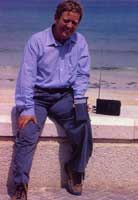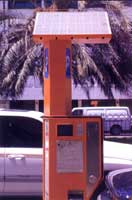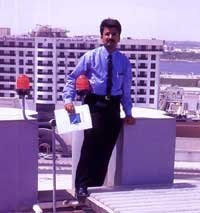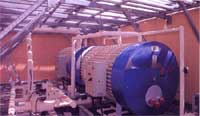Energy's bright future?
Solar energy is clean, plentiful and extremely reliable. Penelope Lane finds out why the power of the sun has not been fully harnessed in a region that sees more than 300 sunny days each year.
 Think of it as power from a nuclear reactor, without the bother of wondering where to put all that spent uranium, the menace of those black-on-yellow radioactivity hazard warnings and the hordes of environmentalists the featureless reactor domes are bound to attract. It is clean, plentiful and extremely reliable power which streams steadily out of a reactor 93 million miles away: the Sun.
Think of it as power from a nuclear reactor, without the bother of wondering where to put all that spent uranium, the menace of those black-on-yellow radioactivity hazard warnings and the hordes of environmentalists the featureless reactor domes are bound to attract. It is clean, plentiful and extremely reliable power which streams steadily out of a reactor 93 million miles away: the Sun.
Worldwide, solar energy is an industry that is growing at 40 percent per year, both in terms of the total value of energy-related goods and services produced and billed for, and in terms of capacity added. For governments that have over the last two decades and more put in place elaborate programmes that include multi-tiered subsidies and incentives relating to fossil fuel-based power, this is somewhat worrying. For consumers, both at home and at work, this is a very clear road away from the hydrocarbon age.
Either way, the irony in this part of the world is that barring a few tentative projects, the overwhelming bulk of power that is generated from solar cells comes from a very ordinary, very humble source indeed: your solar-powered calculator. Those four or five little purplish squares sitting together in a line on top of that liquid crystal display work every time, without fail, under conditions that would surprise you if you stopped to pay attention to them.
 "Solar has just not been trusted in the region," says Raphael Khlat, general manager of Faisal Jassim Trading, a company that knows a good deal about energy and how it can be used - its primary energy-related business is the supply of heating systems. "Here we have over 300 good solar days a year, and compared to global averages that is a lot." What this means is that compared with North America, the European Union and vast tracts of Asia, the Middle East has very many more sunny days that can be put to good use, if only one had the right equipment.
Khlat and his team study energy: its generation, uses and systems. What evolves naturally from their business is energy efficiency. And because they deal with heating systems, which more often than not involve water heating, they appreciate better than most the complex and dynamic relationship between running costs, start-up costs, and energy that leaks out of a system without being put to use.
"Solar has just not been trusted in the region," says Raphael Khlat, general manager of Faisal Jassim Trading, a company that knows a good deal about energy and how it can be used - its primary energy-related business is the supply of heating systems. "Here we have over 300 good solar days a year, and compared to global averages that is a lot." What this means is that compared with North America, the European Union and vast tracts of Asia, the Middle East has very many more sunny days that can be put to good use, if only one had the right equipment.
Khlat and his team study energy: its generation, uses and systems. What evolves naturally from their business is energy efficiency. And because they deal with heating systems, which more often than not involve water heating, they appreciate better than most the complex and dynamic relationship between running costs, start-up costs, and energy that leaks out of a system without being put to use.
Typically, solar power and solar energy accrues via two different processes:
- a solar collector is the simpler, comprising a trough-shaped metallic dish which faces the sun and concentrates its rays onto a channel that usually runs along the bottom. The channel contains a fluid, most usually water but occasionally oil. This is heated, relies on convection currents to keep in flowing into a holding tank, and there either heats water for domestic use or water which serves as pre-warmed feed for a conventional heater.
- a solar cell also faces the sun and looks for its rays but does a much more complex job. Made of silica, this is the photovoltaic cell, which generates electricity from sunlight. It needs space, operates commercially as part of a huge farm of collectors, and relies on a storage mechanism into which it feeds the collected electricity.
"It's over the last two to three years that I've noticed people looking at solar power," says Khlat, "and when I tell them that they're looking at an energy saving of up to 75-80 percent and a payback period that starts at around four years, that's when they really get interested." He is looking at a market that could be larger than most people think. The Emirates spends between 20 and 30 million Dirhams a year on calorifiers (those are the gizmos which provide the heating) and not more than a million Dirhams on solar heating.
This is a ratio that is heading for steady change. In Dubai alone, several real estate developments - commercial and residential - either already have both conventional and solar systems or will install solar powered systems. Al Bustan's Rotana Suites has only just put in place a solar powered heating system which will do that property's balance sheet a world of good, and Union Properties is reported to have decided on solar as well.
Away from the roofs and under-ceiling sub-systems the use of solar power is almost invisible, not because it works in mysterious ways, but because it is in fact hardly used. Last year, the Dubai Municipality installed several hundred parking meters, slim orange poles that have provoked many a curse from the average motorist. They are all powered by a compact photovoltaic panel that sits on them like a cap. Elsewhere, up in the hills of Hatta photovoltaics power Etisalat's telecom relay stations and in the oilfields, they provide the electrical juice that keeps remote telemetry and communications monitoring systems running smoothly, reliably, day after day.
For men like Alan Dickson, a solar power evangelist but who, by his own admission is now a power "realist", the oilfields are not the best customers a seller of solar equipment can have. "The order are one-off and there is little repeat business," says Dickson with just a touch of rue. Photovoltaics are notoriously long-lasting and rugged. Once in place and running, they are quite happy being simply forgotten about and are not your average sales manager's fast moving consumer good.
Dickson, managing partner of Solstice International, holds a doctorate in the field and runs his little Sony radio off a small five-by-four inch photovoltaic array. He came to the region because he figured that with so much sun here, there would very likely be so much opportunity for proselytising in the name of the solar. Several years later, the bulk of his sales go to the Indian sub-continent, various regions in Saharan Africa and numerous villages somewhere in Afghanistan's hill tracts.
 "Solar works best when you're off-grid," he explains. Of course in the regions that his products go out to, the grid might be a couple of hundred kilometres away. His usual approach is to advise caution to the starry-eyed enthusiasts who walk into his Sheikh Zayed Road shop. "They come in here thinking it's cheap and it's easy. But the truth is that start-up is expensive because apart from the costs of the panels there are the associated control mechanisms, cabling requirements and junction boxes." Dickson's advice is blunt but clear: if you're trying to save money, think again because using the mains can be a lot cheaper. If you're looking for a power source where reliable power is scarce, then consider solar.
"Solar works best when you're off-grid," he explains. Of course in the regions that his products go out to, the grid might be a couple of hundred kilometres away. His usual approach is to advise caution to the starry-eyed enthusiasts who walk into his Sheikh Zayed Road shop. "They come in here thinking it's cheap and it's easy. But the truth is that start-up is expensive because apart from the costs of the panels there are the associated control mechanisms, cabling requirements and junction boxes." Dickson's advice is blunt but clear: if you're trying to save money, think again because using the mains can be a lot cheaper. If you're looking for a power source where reliable power is scarce, then consider solar.
"When you're working with solar the upside is that system life is long and the system is modular, so you can add units as you grow. And over a project life cycle of 20 years you're looking at, with today's prices, costs of Dh 1.5 to 2 per kilowatt hour," he says. "That's the reason solar power is expanding as fast as it is. But I tell them all when they come in here that there's a simple rule of thumb: if your load is less than 5 kWh/day then go for solar, otherwise stick with a diesel generator."
The region has certainly not suffered a dearth of interest in solar. Way back in 1984 at a symposium on energy use, Sheikh Nasser Al-Ahmed Al-Jaber Al-Sabah, Kuwait's Minister of Information, said: "The world does not have many years in which to make a smooth transition from oil to alternative sources of energy. The facts are plain. Current oil consumption continues to exceed new discoveries. The world has only a few decades in which to make this transition. Indeed, several countries of the Arab Gulf may have even less time in which to find an alternative source of national income."
Between then and now, the 'transition' in the Middle East has been very subdued. The energy crises of the 1970s prompted considerable research into solar power but by the mid-80s that flare of interest and activity waned. Oil had fallen to a quarter its peak price at the height of the crisis and interest in some cases even did an about-turn: one of the first actions of the Ronald Reagan administration was to remove solar heating panels installed on the White House under Jimmy Carter! Corporate investment in solar energy made during the 70s either sold out or closed down and the proponents of solar power began to be viewed not as energy scientists but as slightly nutty environmentalists.
Yet five years ago, Shell Petroleum predicted that renewable energy and in particular solar would dominate world energy production by 2050. Shell Petroleum has since entered into a rapidly expanding solar market along with Siemens, Enron, Canon, Sanyo and a host of other large corporations. This revival in interest has been for several reasons - today's solar modules cost a third of what they did ten years ago. And they are far more efficient.
 Increasing domestic consumption due to rising populations, living standards and industrialisation is already having implications locally. "Last year's summer," points out Dickson, "saw power cuts in many areas of Saudi Arabia as electricity supply, mainly for air conditioning, was unable to meet seasonal demand." As populations and living standards continue to increase in GCC states, domestic demand will further reduce the amount of oil available for export. To meet rising demand the UAE is planning to increase power generation by 70 per cent when 2005 comes around, and over the same period Saudi Arabia is expected to more than double its capacity at a cost of $58 billion.
To the financial underwriter of a solar-based project, this is a technology that still costs more than traditional power generation, but the gap is narrowing, not as swiftly as most solarists would like, but certainly fast enough to be taken seriously as an energy alternative. From a commercial point of view the major failing of most renewable energy sources is they are often dependent on the weather, and that is apart from the problems of storing large quantities of electricity.
Increasing domestic consumption due to rising populations, living standards and industrialisation is already having implications locally. "Last year's summer," points out Dickson, "saw power cuts in many areas of Saudi Arabia as electricity supply, mainly for air conditioning, was unable to meet seasonal demand." As populations and living standards continue to increase in GCC states, domestic demand will further reduce the amount of oil available for export. To meet rising demand the UAE is planning to increase power generation by 70 per cent when 2005 comes around, and over the same period Saudi Arabia is expected to more than double its capacity at a cost of $58 billion.
To the financial underwriter of a solar-based project, this is a technology that still costs more than traditional power generation, but the gap is narrowing, not as swiftly as most solarists would like, but certainly fast enough to be taken seriously as an energy alternative. From a commercial point of view the major failing of most renewable energy sources is they are often dependent on the weather, and that is apart from the problems of storing large quantities of electricity.
Yet there are obvious energy demand and energy availability synergies: in most Arab states peak electricity demand is mainly for air-conditioning, which is required most in the early summer afternoons. This demand depends on the intensity of sunlight and as the output of solar panels also hit their maximum at about the same time, supply and demand parallel each other, a situation which makes the economics of solar generated electricity viable.
How close are we then to what Abdullah Juma, Bahrain's Minister of Electricity and Water, talked about when he called in May 1997 for solar power to be "the backbone of regional power generation"? Not close enough, since electricity throughout the GCC is still heavily subsidised and governments are attempting to reduce subsidies while encouraging consumers to reduce their consumption of electricity and water.
Yet Dickson's indestructible cells and Khlat's fired-up collectors are steadily helping the Emirates understand just how valuable that awesome reactor up there in the sky really is.
The Future
Solar power engineers and photovoltaics experts firmly believe that the medium-term market for photovoltaics will mainly be in and on buildings. There are several key reasons for this:
- The use of what is called "distributed system architecture" - which simply put means the advantage of collecting sunlight from virtually anywhere on a building's surface and sending it to the nearest point that needs the power - greatly reduces the cost of transmission and distribution of electricity.
- The electricity produced is valued at the user's price as opposed to the bulk supplier's cost. This is perhaps the most attractive factor for project managers and real estate badshahs. Certainly, the value of the photovoltaic energy can vary depending on building load profiles, utility rate structures, and the availability of net metering, but it is almost always higher than the value of PV energy produced in a central station plant.
- In completely integrated configurations, the photovoltaic arrays can actually replace building materials and thereby generate a tremendous 'credit' toward the price of the PV equal to the value of whatever material is being replaced. What, again, this means simply is that instead of using a typical cladding material such as plate glass, metal, marble or polished stone, the building can be cladded with PV arrays. In some cases, for example vis-=E0-vis polished stone, the cost is almost comparable. Building and home owners may be motivated to use PV for altruistic, promotional purposes or to be labeled 'green' even where the economic justification is marginal with respect to grid power.
|
BP-Amoco's place in the sun
This April, BP Amoco stepped up investment in its growing solar energy business with the $45 million purchase of the balance 50 per cent stake in Solarex, one of the world's leading solar companies in the US. The buyout of what was previously a 50:50 joint venture between Amoco and Enron created the largest solar company in the world.
The integrated company is called BP Solarex and builds on the current business activities of Solarex and BP Solar. With annual revenues of more than $150 million, the company represents a 20 per cent share of the global market and has manufacturing operations in four countries - the USA, Spain, Australia and India, producing around 30 megawatts of solar products each year.
BP Solarex says it is aiming at "prime positions" in leading-edge solar technology, most notably the new generation of thin films, as well as offering the world's broadest product range in crystalline silicon. The acquisition is another significant step towards BP Amoco's target of building a $1 billion solar business over the next decade.
The company has since 1984 put in place a number of solar powered solution:
| 1992 |
UAE |
Offshore platform safe area power supplies |
| 1991 |
Egypt |
Solar cathodic protection systems |
| 1990 |
Tunisia |
Pipeline cathodic protection systems |
| 1990 |
Sudan |
Obstruction lighting at river crossing |
| 1990 |
Qatar |
Platform solar power system |
| 1989 |
Libya |
Pipeline cathodic protection systems |
| 1986 |
UAE |
Five offshore platform power supplies |
| 1985 |
Iraq |
Solar cathodic protection systems for crude oil pipelines |
| 1985 |
Abu Dhabi |
Obstruction lighting systems |
| 1985 |
Egypt |
Solar powered cathodic protection systems |
| 1984 |
Saudi Arabia |
Airfield obstruction lights |
Saudi telecom goes solar
ASE Americas, which is owned by Angewante Solar Energies (part of the RWE/Nukem group), is undertaking a multi-million dollar contract for solar cells and technology transfer with Al Jazirah Solar of Saudi Arabia for one of the world's largest telecom projects.
The solar cells power cellular sites for Lucent Technologies International as part of its contract for the expansive Telephone Extension Project in Saudi Arabia. Solar modules provided by Al Jazirah Solar Systems are the fundamental power source for the project. ASE Americas provided Al Jazirah Solar Systems the materials, manufacturing technology, and technical expertise needed to attain in-house manufacturing capabilities. ASE Americas' large area 300-watt modules are also used for US military large-scale projects.
Satellites to calculators
The 'Photovoltaic Effect', where certain materials generate electricity when exposed to light, was first observed in 1839 and explained by Albert Einstein in 1905. Early devices were inefficient but in the 1950s Bell Laboratories developed more efficient silicon photovoltaic cells which were installed on America's first space satellite, Vanguard. At that time photovoltaics were an astronomically expensive technology and cost about $200,000 per watt.
Since then practically all satellites including the Hubble Space Telescope have been powered by solar cells. Mir, the space station that refuses to become another Skylab and Sojourner, the robot exploration vehicle that bumped around the surface of Mars, both brought solar power to the front pages. The price of solar cells is not as prohibitive as it was in the first years of the space race: on large orders it now costs about $2.40 per peak watt and further reductions seem inevitable as more companies enter the field. Solar cells are probably best known to us as the little purple stripes that power our solar calculators. Since 1975 the worldwide production of PV cells has increased over 100-fold and is now about 150 megawatts per year. Applications include consumer goods such as the ubiquitous calculator and larger systems for lighting, refrigeration, water pumping and communications in remote areas with no grid supply. Recent developments in photovoltaics include large commercially viable solar power farms and 'Building Integrated Systems'
Bigger is better
The largest grid-connected photovoltaic station is near Naples in Italy and has a peak output of 3.3 megawatts. Before the BP-Amoco merger, Amoco/Enron Solar signed a deal with the Greek government to build a 50Mw solar farm on Crete, and have plans for 100 Mw power plants in Nevada and even larger facilities in China, India and Pakistan. By using new technology and large automated production facilities, these plants will generate electricity competitive with fossil fuels. Such large power plants will have to be on land of little or no agricultural or commercial value, but near most of the worlds' cities land is usually costly, a factor not so important in the arid GCC states. |